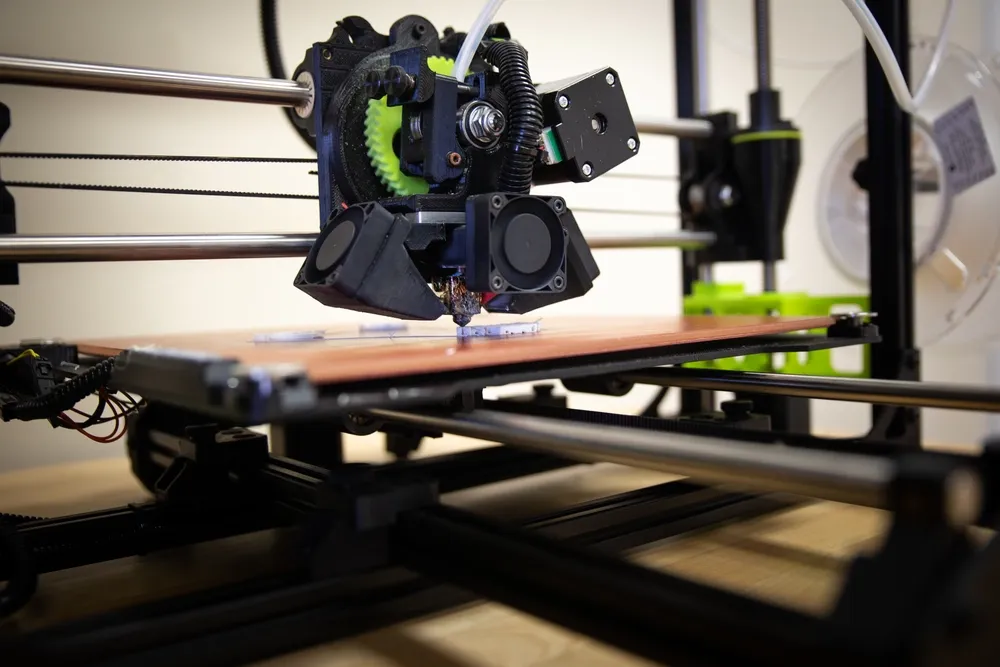The Rise and Implementation of Additive Manufacturing
By: Emily Wu and Mayher Bedi

Introduction
Additive Manufacturing, the industrial term behind three-dimensional printing, is the idea of constructing a product by building it one layer at a time using materials such as plastics/polymers, composites, metals, ceramics, and glass. To create an object using additive manufacturing, someone must first create the design. These creators can be as specific as researchers in the healthcare application, or as broad as someone designing products for the consumer. This is typically done using computer aided design, or CAD software. The software then translates the design into a layer by layer framework for the additive manufacturing machine to follow. This design is sent to the 3D printer, which begins creating the object immediately (Linke).
The global 3D printing market size was valued at USD 13.84 billion in 2021 and is expected to expand at a compound annual growth rate (CAGR) of 20.8% from 2022 to 2030. Globally, 2.2 million units of 3D printers were shipped in 2021 and the shipments are expected to reach 21.5 million units by 2030 (Grand View Research). The aggressive research & development in three-dimensional printing and the growing demand for prototyping applications from various industry verticals, particularly healthcare, automotive, and aerospace and defense, are expected to fuel the growth of the market.
Trade-Offs between Industrial Manufacturing (IM) and Additive Manufacturing (AM)
Although AM retains multiple applications across different industries, some trade-offs for using AM compared to traditional types of manufacturing still exist, including issues with cost, skill barriers, and hardware/software capabilities.
The biggest issue seems to be cost. High volume products, such as water bottles, are not going to need the supply chain flexibility that maybe the healthcare or fashion industry may need. Additive manufacturing (AM) applied here is just a higher unit cost. The materials needed to manufacture such AM machines are expensive as well. Industrial AM machines can range anywhere from $25,000 to $500,000, with service contracts to repair such machines costing about 15% of a machine’s purchase price (BigRep). Special polymers and processing required to convert metal alloys into a powder form for AM machines also add to expensive machine manufacturing costs.
Another trade-off is the shifted labor skill set required by AM employers. IM laborers weren’t too demanding on the skill set required for their employees as they needed to fulfill a certain role that was taught by the company itself and didn’t require extensive education. However, AM demands a whole new skill set all together. This lag has created “the additive manufacturing skills gap”; the notion that there are simply not enough talented professionals to fill jobs and thus meet the needs and demand from the AM employers.
Another issue with AM resides in restrictions with hardware and software. AM machines possess slow speed and volume build limits, which restrict the range of possible applications AM has. This results in a necessity for combining the manufacturing and processing productions from multiple vendors. In addition, AM equipment may require vendor specific software control, which can lead to limited integration between different machines. At the end of the day, the technology required to achieve a consistent quality and productivity within the products AM creates can be difficult to procure.
Although trade-offs occur between IM and AM, the rise of Additive Manufacturing and its applications have become widespread across many industries. Details about each industry application are listed below. Specifically, we examine healthcare, industrial, and real estate applications.
Healthcare Application
Due to shortages in equipment from the COVID-19 pandemic, a surge in demand for 3D printing in the healthcare industry occurred. Technological advancements in customization, larger user demographics, and increasing applications in biomedical sectors have allowed AM technologies and innovations to excel in the medical devices industry. The global healthcare 3D printing market size is estimated to be around $1.45 billion in 2021, with a CAGR of 20.10% (Globe Newswire). A large factor of this increasing growth of AM in medical devices can be attributed to the mass customization and flexibility innovation in specialized applications 3D printing provides. Anatomical models, surgical guides, prosthetics and implants, and personalized drugs have imposed incredible innovations and benefits onto patients and clinicians (McKinsey).
Anatomical models
Biomedically realistic models are highly functional and allow for training and validation of various medical devices. Anatomical models, which possess accurate anatomical representations, have allowed healthcare professions to receive in-depth pre-surgical education and training (Javelin). Models can be printed and generated on demand from CAD models, and retain the potential for transforming the future of pre-surgical trainings. According to the American Hospital Association, utilizing 3D models as surgical guides have reduced surgical times and costs by substantial amounts. Specifically, surgical times have been reduced by an average of 62 minutes, with savings of $3k+ per case(Academic Radiology).
Surgical guides
Surgical guides have become increasingly popular in recent years and are an advancement in dental implant technologies. These guides are plastic, retainer-like objects and are placed over a patient’s mouth to allow surgeons to position dental implants in ideal locations in a patient’s mouth. A typical workflow process of surgical guides involves using an intraoral 3D scanner, designing on an implant planning software, digital fabrication using a specialized software, and finally assembly and sterilization (SprintRay). The results of using AM on surgical guides have been reductions in operating time and an increase in the improvement of patient outcomes. Creating these surgical guides in house reduces time to complete guides and costs.
Prosthetics
3D printing has allowed the field of prosthetics to create new innovations, customizations, and cheaper products. A large issue facing rehabilitative medicine, specifically in regards to prosthetics, is the labor intensiveness and high price points. With the innovation of 3D prosthetics, solutions to these problems have been developed, with generative design and 3D printing to allow prosthetics to be manufactured at cheaper prices and with higher customizability to patients who need them (Sculpteo). This level of customization with 3D printed prosthetics not only allows for better personalization, but also higher comfort levels for users. In addition, 3D printing has tremendously affected bone and cartilage restoration and could potentially transform how patients are treated. Emerging research and development from institutions such as the University of California Berkeley and the University of Washington, convey the potential 3D printing provides to creating on-demand organ and other human anatomical structure printing.
Personalized medicine
Personalized medicine, a type of medicine that utilizes a patient’s genomics to issue prescriptions, has become increasingly popular in recent years. They allow multiple doses to be combined into one type of dosage. When AM is applied to this, a variety of dosage forms, drug combinations, and release profiles are created. The effects of this application are optimized dosing for patients and ideal accommodations for the different drug-release profiles. Again, the use of AM applications in personalized medicine facilitates better customization to patients.
Industrial Application
The aerospace and defense (A&D) industry is one of the earliest adopters of 3D printing, with the first use of the technology going back to 1989. Now, three decades later, A&D represents a 16.8% share of the $10.4 billion additive manufacturing market and heavily contributes to ongoing research efforts within the industry (AMFG).
- Low-volume production: 3D printing appeals to industries in need for highly complex parts as additive manufacturing technology allows for the production of complex geometries. This offers a cost-effective way to produce small batches of parts needed for industries like aerospace and defense without having to invest in expensive tooling equipment.
- Faster part delivery: With the addition of a 3D printer in house, it reduces the friction between tooling and design and allows for the ability to integrate multiple parts into a single component without having to outsource individual parts. Reducing the number of parts needed can significantly simplify the assembly and maintenance process by reducing the amount of time needed for assembly.
- Lower production parts: Additive Manufacturing accounts for material efficiency, lowering the operating costs of delivery and outsourcing materials. The same materials parts in the same area allows for weight reduction of products and the personalization ability at a lower cost.
- Maintenance & repair: The average lifespan of an aircraft can range between 20 and 30 years, making maintenance, repair and overhaul (MRO) an important function in the industry. Metal 3D printing technologies like Direct Energy Deposition are commonly used to repair aerospace and military equipment. Turbine blades and other high-end equipment can also be restored and repaired by adding material to worn-out surfaces.
Real Estate Application
Additive manufacturing technologies make it possible to create more complex shapes, build walls faster, and reduce labor costs. The aim with the 3D printed homes is to reduce the overall cost of infrastructure in communities with economic problems (V. Carlota). Many construction companies, such as ICON, Alquist 3D, and Lennar, have already started to 3D print buildings or houses.
Alquist 3D brings new vitality to smaller communities by creating affordable, sustainable, innovative homes. Alquist helps lift economically distressed and under-served communities by lowering the cost of building the single-family, multifamily, mixed-use, and senior-living homes they need to thrive.
Recently, they announced the launch of one of its new projects for Habitat for Humanity for 3D printing homes: a two-hundred home project located in Virginia. This initiative is intended to be one of the largest housing construction projects, with Pulaski and Roanoke being the first cities to be chosen for it, due to the growth in demand for housing that these areas have experienced in recent years.
In 2023, another one-hundred home community will be built in the scenic San Gabriel River. This Wolf Ranch community of 3D-printed homes will be built by ICON in collaboration with Lennar, one of the nation’s leading homebuilders, and codesigned by BIG-Bjarke Ingels Group (ICON). The innovative community of one hundred 3D-printed homes features eight floorplans, 24 elevations and will be powered by the sun with rooftop solar panels, aiming to partner with renewable energy trends.
Major Players
Finally, to gain a deeper understanding of the current 3D printing landscape, we examine the markets available to printing companies. Currently, the industry is dominated by multiple major players, but most notably, Protolabs, Nano Dimensions, and Markforged. These three companies have a large impact on the 3D printing market as of late due to the sizes of their market cap, manufacturing speeds, and future growth potential (Manufactur3D).
Protolabs is an e-commerce driven digital manufacturer of custom prototypes and on-demand production parts. Their business proposition consists in offering fast prototyping and price quotes. Their efficient prototyping is achieved through their focus on low volume and high quality, which allows them to provide competitive price quotes.
They typically service a variety of industries, such as medical device, consumer product, automotive, and aerospace. Due to privacy restrictions, Protolabs doesn’t disclose a list of their customers, but success stories on the company’s website details products such as as parts for a Nokia 5-G Capable Security Drone and custom sheet metal parts for NASA (Protolabs).
Nano Dimension is a 3D printing company that focuses on the research and development of 3D printed electronics that includes a printer for multilayer printed circuit boards and the development of nanotechnology inks. Nano Dimensions is a provider of intelligent machines for the fabrication of additively manufactured electronics (AME) and they differentiate themselves by focusing on environmentally responsible processes.
Markforged Holding Corporation is a provider of industrial additive manufacturing platforms. The company offers desktop, industrial, and metal 3D printers; and composite, continuous fiber, and metal parts, as well as advanced 3D printing software. Its platform, The Digital Forge, is an industrial additive manufacturing platform that combines 3D printers and both metal and composite materials with its cloud-based software.
Its portfolio of 3D printers includes desktop printers, industrial printers, and metal printers. Its industrial materials enable engineers to develop functional parts across manufacturing environments and applications. The Company offers four fibers: carbon fiber, fiberglass, kevlar, and high-strength high-temp (HSHT) fiberglass. Markforged transforms manufacturing with 3D metal and continuous carbon fiber printers capable of producing parts tough enough for the factory floor. It serves customers in aerospace, military and defense, industrial automation, space exploration, healthcare, and automotive industries.
Conclusion
Additive Manufacturing possesses applications in multiple industries, transforming the products and services of sectors such as healthcare, industrial, and real estate. Drawbacks to AM, such as costs and hardware and software restrictions may have prevented a more rapid and widespread adoption of 3D printing. The future of AM, with its ability to make customized products for consumers and ability to create parts on demand shows promise for its potential for applications into numerous other industries.
Works Cited:
“3 Ways 3D Printing Is Revolutionizing Health Care: AHA.” American Hospital Association, https://www.aha.org/aha-center-health-innovation-market-scan/2022-06-07-3-ways-3d-printing-revolutionizing-health-care.
“3D Community.” New Story, 24 Feb. 2022, https://newstorycharity.org/3d-community/.
“3D Printing Dental Surgical Guides.” Formlabs, https://dental.formlabs.com/indications/surgical-guides/.
“3D Printer Cost: What You Need to Know before You Buy.” BigRep Industrial 3D Printers, 7 Apr. 2022, https://bigrep.com/posts/3d-printer-cost/
3D Printing Market Size & Share Report, Grand View Research, 2022-2030, https://www.grandviewresearch.com/industry-analysis/3d-printing-industry-analysis#:~:text=The%20global%203D%20printing%20market,21.5%20million%20units%20by%202030.
“3D Technology.” ICON, https://www.iconbuild.com/.
Amor Santosarambulo, Alexandra. One for the Books [Image 3 of 5]. 15 July 2020. Defense Visual Information Distribution Service, https://www.dvidshub.net/image/6301947/one-books.
“Anatomical Models.” Javelin 3D Solutions, 15 Jan. 2020, https://www.javelin-tech.com/3d/process/anatomical-models/.
Bromberger, Jörg, et al. “The Mainstreaming of Additive Manufacturing.” McKinsey & Company, McKinsey & Company, 16 Mar. 2022, https://www.mckinsey.com/capabilities/operations/our-insights/the-mainstreaming-of-additive-manufacturing.
Gaget, Lucie. “3D Printing Prosthetics in 2022: The Great Revolution.” Sculpteo, Sculpteo, 3 Oct. 2022, https://www.sculpteo.com/en/3d-learning-hub/applications-of-3d-printing/3d-printed-prosthetics/.
“Guide to 3D Printing Surgical Guide.” SprintRay Inc., 25 Nov. 2021, https://sprintray.com/guide-to-3d-printing-surgical-guide/.
“Industrial Applications of 3D Printing: The Ultimate Guide” AMFG, https://amfg.ai/industrial-applications-of-3d-printing-the-ultimate-guide/.
Linke, Rebecca. “Additive Manufacturing, Explained.” MIT Sloan, 7 Dec. 2017, https://mitsloan.mit.edu/ideas-made-to-matter/additive-manufacturing-explained.
“Manufacturing Case Studies.” Protolabs, https://www.protolabs.com/resources/success-stories/
“The World's Largest 3D Printing Companies by Market Cap: 3D Systems & Xometry on Top.” Manufactur3D, 25 Sept. 2022, https://manufactur3dmag.com/the-worlds-largest-3d-printing-companies-by-market-cap-protolabs-3d-systems-on-top/
V., Carlota. “3D Printed Houses: A Closer Look at Completed Projects from around the World.” 3Dnatives, 16 Aug. 2022, https://www.3dnatives.com/en/3d-printed-houses-market-250220204/#.



